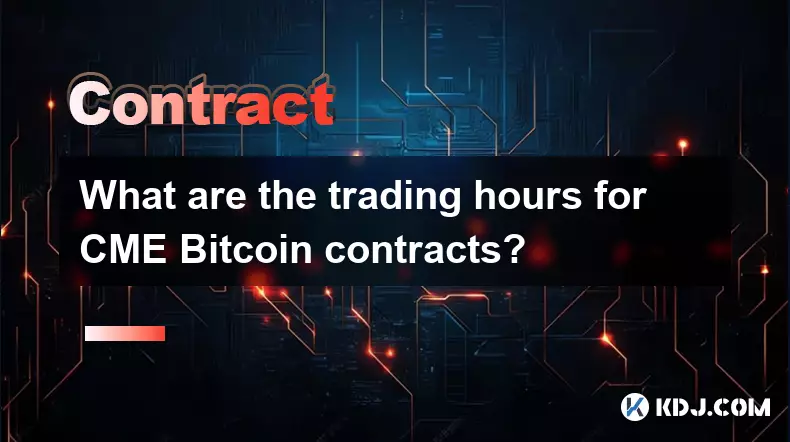-
 bitcoin
bitcoin $105968.894684 USD
4.17% -
 ethereum
ethereum $3639.320047 USD
7.62% -
 tether
tether $1.000339 USD
0.06% -
 xrp
xrp $2.407774 USD
5.96% -
 bnb
bnb $1011.704193 USD
2.28% -
 solana
solana $166.942754 USD
6.37% -
 usd-coin
usd-coin $1.000143 USD
0.03% -
 tron
tron $0.291515 USD
0.25% -
 dogecoin
dogecoin $0.181682 USD
4.06% -
 cardano
cardano $0.585450 USD
4.54% -
 hyperliquid
hyperliquid $42.099968 USD
5.20% -
 chainlink
chainlink $16.160745 USD
5.45% -
 zcash
zcash $645.269648 USD
12.96% -
 bitcoin-cash
bitcoin-cash $507.430338 USD
2.80% -
 stellar
stellar $0.290357 USD
3.69%
What are the trading hours for CME Bitcoin contracts?
CME Bitcoin futures trade nearly 24/7, pausing daily at 4–5 p.m. CT for settlement, with Friday closes at 4 p.m. and Sunday restarts at 5 p.m. CT.
Nov 06, 2025 at 02:59 pm

Understanding CME Bitcoin Futures Trading Schedule
1. The CME Group offers Bitcoin futures contracts that trade nearly around the clock, aligning closely with global cryptocurrency market activity. Trading begins on Sunday at 5:00 p.m. Central Time (CT) and continues through Friday afternoon.
2. Regular trading halts daily from 4:00 p.m. to 5:00 p.m. CT for maintenance and price settlement. This one-hour break occurs every weekday and also applies during weekends except for the Sunday restart window.
3. On Fridays, the final trading session ends at 4:00 p.m. CT, followed by the daily closure until Sunday evening. This structure allows institutional traders and market participants to reassess positions over the weekend.
4. The electronic trading platform, CME Globex, facilitates most Bitcoin futures transactions. Its extended hours reflect the continuous nature of crypto markets, even though traditional financial instruments often follow rigid exchange schedules.
5. Contract expirations occur quarterly—March, June, September, and December—with additional listings sometimes available for monthly expiries depending on market demand and regulatory approvals.
Key Features of CME Bitcoin Futures
1. These futures are cash-settled, meaning no physical delivery of Bitcoin takes place upon contract expiration. Instead, settlements are based on the CME CF Bitcoin Reference Rate (BRR), which aggregates trading data from major spot exchanges.
2. Institutional adoption has grown due to the regulated nature of CME contracts. Banks, hedge funds, and asset managers use them for hedging exposure or gaining leveraged access without holding actual digital assets.
3. Margin requirements are enforced in line with traditional derivatives, offering a familiar risk management framework for conventional finance players entering the digital asset space.
4. Price limits and circuit breakers are active during trading sessions to prevent excessive volatility, a feature absent in many decentralized crypto exchanges.
5. The presence of open interest data provides transparency into market sentiment, enabling traders to analyze positioning trends across different expiry months.
Impact on Broader Crypto Markets
1. Large trades in CME Bitcoin futures can influence spot prices, especially when institutional flows signal directional bets ahead of macroeconomic events like Federal Reserve announcements.
2. Open interest spikes often precede increased volatility in the underlying Bitcoin market, as retail traders react to perceived smart money movements captured in futures data.
3. Settlements at 4:00 p.m. CT contribute to recurring intraday price patterns, with some analysts noting increased volume and momentum around these times due to index rebalancing and position unwinding.
4. Regulatory clarity surrounding CME-listed products enhances legitimacy for Bitcoin as an asset class, encouraging further integration into mainstream investment portfolios.
5. Competing derivatives platforms monitor CME pricing benchmarks, using them as reference points for their own settlement mechanisms, thereby amplifying its systemic importance.
Frequently Asked Questions
What time does CME Bitcoin futures trading resume after the weekend?Trading resumes on Sunday at 5:00 p.m. Central Time (CT) via the CME Globex electronic platform, allowing early positioning before the new week’s market activity accelerates.
Are CME Bitcoin futures physically delivered?No. All contracts are cash-settled using the CME CF Bitcoin Reference Rate (BRR). Traders receive or pay the difference in value in U.S. dollars rather than receiving actual Bitcoin.
How does the daily trading halt affect liquidity?During the 4:00 p.m. to 5:00 p.m. CT pause, order books are cleared and prices are settled. Liquidity typically rebuilds rapidly once trading resumes, particularly if significant news emerges during the break.
Can retail investors trade CME Bitcoin futures?Yes, provided they have access to a brokerage account that supports futures trading and meet the necessary margin requirements. However, the complexity and capital demands make these instruments more common among professional traders.
Disclaimer:info@kdj.com
The information provided is not trading advice. kdj.com does not assume any responsibility for any investments made based on the information provided in this article. Cryptocurrencies are highly volatile and it is highly recommended that you invest with caution after thorough research!
If you believe that the content used on this website infringes your copyright, please contact us immediately (info@kdj.com) and we will delete it promptly.
- Bitcoin Price, JPMorgan, and the Crypto Moves You Need to Know
- 2025-11-10 22:50:02
- XRP ETFs in 2026: Will They Reshape the Crypto Landscape?
- 2025-11-10 22:50:02
- Decred Price Prediction: Navigating the Bull Market Buzz
- 2025-11-10 23:05:01
- Brett Coin, Crypto Presale, 1000X Prediction: What's the Hype?
- 2025-11-10 23:05:01
- Starknet (STRK) Price Surges: Decoding the Reasons Behind the Pump
- 2025-11-10 23:15:01
- YouBallin', Pre-sale, and Smart Contracts: What's the Haps?
- 2025-11-10 23:10:01
Related knowledge

What is a Denial of Service (DoS) attack in a smart contract and what are its common forms?
Nov 10,2025 at 05:20am
Understanding Denial of Service in Smart Contracts1. A Denial of Service (DoS) attack in the context of smart contracts refers to a scenario where a m...

How do you safely send Ether to another contract?
Nov 09,2025 at 06:40pm
Sending Ether to Smart Contracts: Key Considerations1. Verify that the receiving contract has a payable fallback function or a designated payable func...

What is a state machine and how can a contract be designed as one?
Nov 08,2025 at 02:19pm
Understanding State Machines in Blockchain Context1. A state machine is a computational model used to design systems that transition between defined s...

How does a bonding curve work and how is it used for token sales?
Nov 09,2025 at 04:00pm
Understanding the Mechanics of Bonding Curves1. A bonding curve is a mathematical function that links the price of a token to its supply. As more toke...

What is a mapping in Solidity and how does it store key-value pairs?
Nov 10,2025 at 12:20pm
Understanding Mappings in Solidity1. A mapping in Solidity is a reference type used to store data in the form of key-value pairs, similar to hash tabl...

How do you upgrade a smart contract using the UUPS proxy pattern?
Nov 09,2025 at 01:19am
Understanding the UUPS Proxy Pattern in Smart Contract DevelopmentThe UUPS (Universal Upgradeable Proxy Standard) pattern has become a cornerstone in ...

What is a Denial of Service (DoS) attack in a smart contract and what are its common forms?
Nov 10,2025 at 05:20am
Understanding Denial of Service in Smart Contracts1. A Denial of Service (DoS) attack in the context of smart contracts refers to a scenario where a m...

How do you safely send Ether to another contract?
Nov 09,2025 at 06:40pm
Sending Ether to Smart Contracts: Key Considerations1. Verify that the receiving contract has a payable fallback function or a designated payable func...

What is a state machine and how can a contract be designed as one?
Nov 08,2025 at 02:19pm
Understanding State Machines in Blockchain Context1. A state machine is a computational model used to design systems that transition between defined s...

How does a bonding curve work and how is it used for token sales?
Nov 09,2025 at 04:00pm
Understanding the Mechanics of Bonding Curves1. A bonding curve is a mathematical function that links the price of a token to its supply. As more toke...

What is a mapping in Solidity and how does it store key-value pairs?
Nov 10,2025 at 12:20pm
Understanding Mappings in Solidity1. A mapping in Solidity is a reference type used to store data in the form of key-value pairs, similar to hash tabl...

How do you upgrade a smart contract using the UUPS proxy pattern?
Nov 09,2025 at 01:19am
Understanding the UUPS Proxy Pattern in Smart Contract DevelopmentThe UUPS (Universal Upgradeable Proxy Standard) pattern has become a cornerstone in ...
See all articles























![🔥 Long awaited! The ancestor of Pi coin is about to take off? PI friends, come in and take a look! [Daily Coin Selection | Bitcoin Trend | Money Making Opportunities] 🔥 Long awaited! The ancestor of Pi coin is about to take off? PI friends, come in and take a look! [Daily Coin Selection | Bitcoin Trend | Money Making Opportunities]](/uploads/2025/11/10/cryptocurrencies-news/videos/6911e42f9bad7_image_500_375.webp)


















































